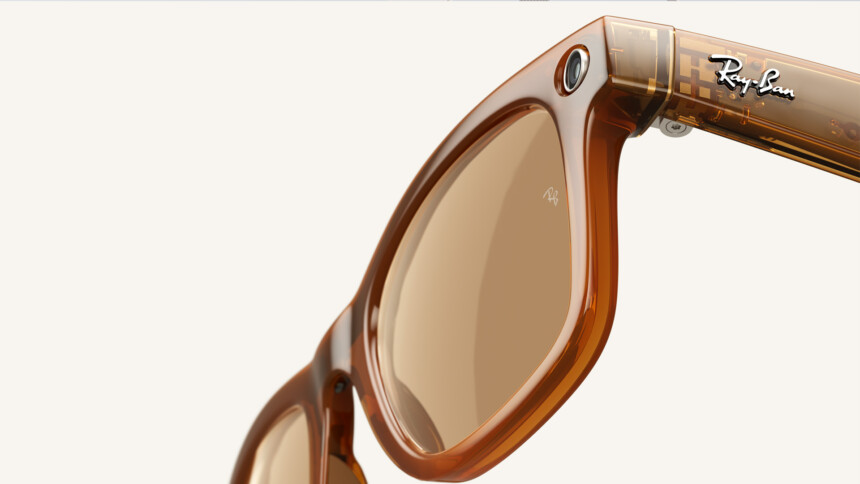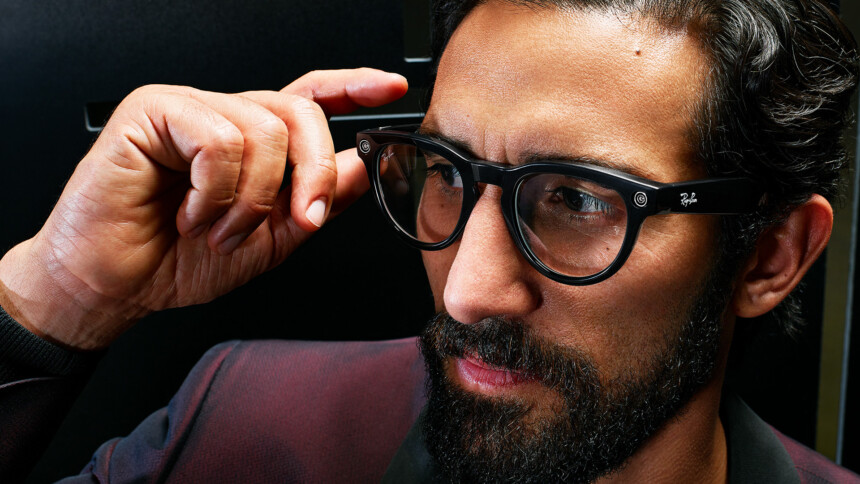Ray-Ban | Meta Smart Glasses hands-on: The Insta-Glasses

The Ray-Ban | Meta Smart Glasses will be hard for streamers and Instagram creators to ignore. But the headset could also appeal to “regular” consumers.
It caught my eye for a moment: The two small cameras in the corners of the Ray-Ban | Meta Smart Glasses worn by several Meta employees at the press event in London on 21 September. Apart from this detail, however, the headsets look like typical Ray-Ban glasses, so after a while I didn't notice them any more.
Why am I bringing this up? Because the question of whether cameras on glasses are acceptable in our society, or if this raises privacy issues, is the first one that comes up in conversations or comment sections. People never tire of resurrecting “Glassholes”, the people who wore Google's Glass smart glasses in 2013 and were repeatedly accused of secretly recording other people.
Ray-Ban Stories had room for improvement
That's hardly a problem these days. At least not a media issue – the media would certainly have loved to pounce on scandal stories surrounding Ray Ban Stories, Meta's first collaboration with luxury eyewear manufacturer Essilor Luxottica for smart glasses.
My colleague Tomislav learned to love Ray-Ban Stories, even if he was in the minority. Many customers were unhappy with the technical stability: connection issues, limited battery life, the cumbersome process of importing photos and videos, and audio weaknesses made them tough to use.

Tomislav with Ray-Ban Stories. | Image: MIXED (TB)
The new generation of Smart Glasses, which Meta unveiled at Connect 2023, is supposed to improve things. However, the first mistake was already made with the unnecessarily complex name: Ray-Ban | Meta Smart Glasses come in the classic Wayfarer and the new Headliner design. Obviously, Meta had to be squeezed in, come hell or high water.
Apart from that, after my ten-minute hands-on session at the press event, I'm hooked. The headsets don't just look good, the technology is pretty cool too.
New chip from Qualcomm brings more power
The new AR1 Gen1 chip from Qualcomm is responsible for the performance. This (and the clever distribution of processors around the frame) powers a 12MP ultra-wide-angle camera that can take photos (3,024 × 4,032) and videos (1,440 × 1,920, 30 FPS, one minute recording time). The 32 GB memory allows you to store around 500 photos.

Close-up of the Ray-Ban | Meta Smart Glasses. You can see the technology shining through. | Image: Ray-Ban / Meta
The sound comes through open speakers, but unlike its predecessor, the sound is supposed to be barely audible from the outside. I couldn't tell from the demo how well this works. What I can say, however, is that the sound is quite powerful for such speakers. The output also supports directional audio, surround sound so to speak.
I was also able to record this surround sound myself using the Ray-Ban | Meta Smart Glasses. Five microphones are placed around the headset to ensure optimal ambient recording. I listened to the result of such a recording directly through the headset's speakers: I was struck by the clarity and precision of the direction from which the audio was coming.
Intuitive controls and a flashing “recording” warning
A touch panel on the right-hand side of the glasses allows you to increase or decrease the volume, for example, by swiping forward or backward on the temple. The input is both intuitive and fairly accurate. However, voice control worked even better, at least when it came to starting and stopping recording.

The controls of the Ray-Ban | Meta Smart Glasses work pleasantly well, as you can tell from my expression. | Image: MIXED, Meta
When you take a picture or a video, a 2 mm white LED on the headset flashes quite brightly. If you want to hide it, you'll have to be pretty clever (you can't just paste it over, or the left camera will go blind). Pictures and videos can then be reviewed, edited and shared on Instagram, for example, using the companion app on your smartphone.
Insta-Glasses with a difference
In general, Ray-Ban | Meta Smart Glasses are very much designed for Instagram and other Meta platforms. Not only the portrait format, which is the only one available when taking pictures and videos, but also the new livestreaming function are directly tailored to Meta's most successful social media platform.
There's a special feature with the livestreaming feature that makes Ray-Ban | Meta Smart Glasses a must-have for content creators on Instagram: the ability to switch directly from the smartphone camera to the glasses' camera in live mode. Switching between the selfie-view, when you want to talk into the camera, and the first-person view, is possible in a matter of seconds with a single tap on the smartphone.
Ray-Ban | Meta Smart Glasses: Not just for influencers
Weighing just under 50 grams, the smart glasses are only slightly heavier than a normal pair of sunglasses and come in 21 different styles. Corrective lenses can be fitted by an optician. The glasses can be used for up to four hours at a time, depending on the intensity of use. Tests will have to show how this works during normal use throughout the day. Charging should take around 75 minutes and is done using the supplied case, which provides around eight charging cycles before it needs to be recharged.

The Ray-Ban | Meta Smart Glasses are not only suitable for influencers. | Image: Ray-Ban / Meta
Of course, a long-term test will have to show how stable everything is and whether it always works as smoothly as in the demo version. But I have to say that, as someone who has not yet created much video content, I find the Ray-Ban | Meta smart glasses quite attractive. Not only for content in general, but also to quickly capture experiences, panoramas, or other memorable moments.
Of course, you can do this with a smartphone, but the smart glasses promise a more direct, intuitive and easier workflow.
What I'd still like to try out are functions like making phone calls or writing text messages – unfortunately, I haven't had the chance yet. As the Ray-Ban | Meta smart glasses do not have a display, this is done by voice recognition and I am curious to see how the quality is compared to other voice assistants such as Google, Amazon's Alexa or Apple's Siri.
Ray-Ban | Meta Smart Glasses will go on sale on 17 October 2023 and start at $329.
You can buy Ray-Ban | Meta Smart Glasses here
- You can currently order them at Amazon USA.
Note: Links to online stores in articles can be so-called affiliate links. If you buy through this link, MIXED receives a commission from the provider. For you the price does not change.